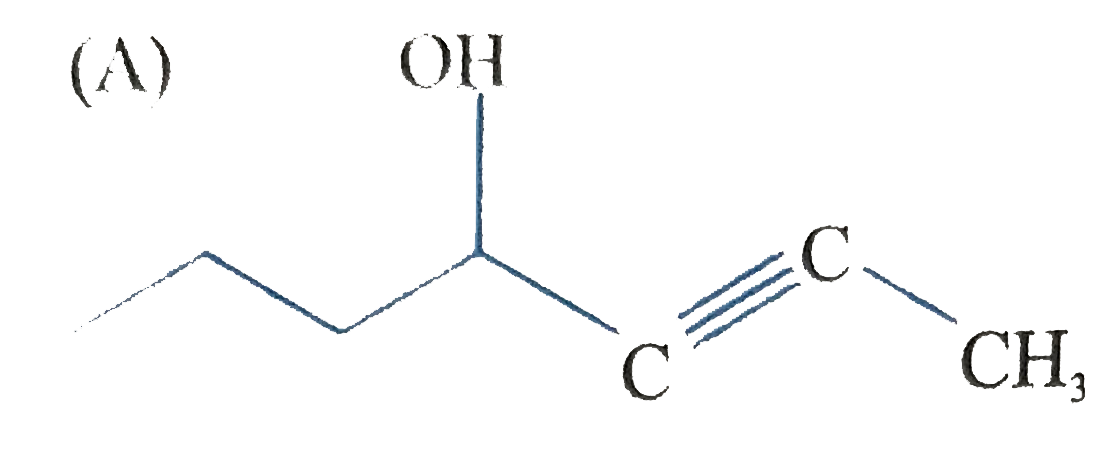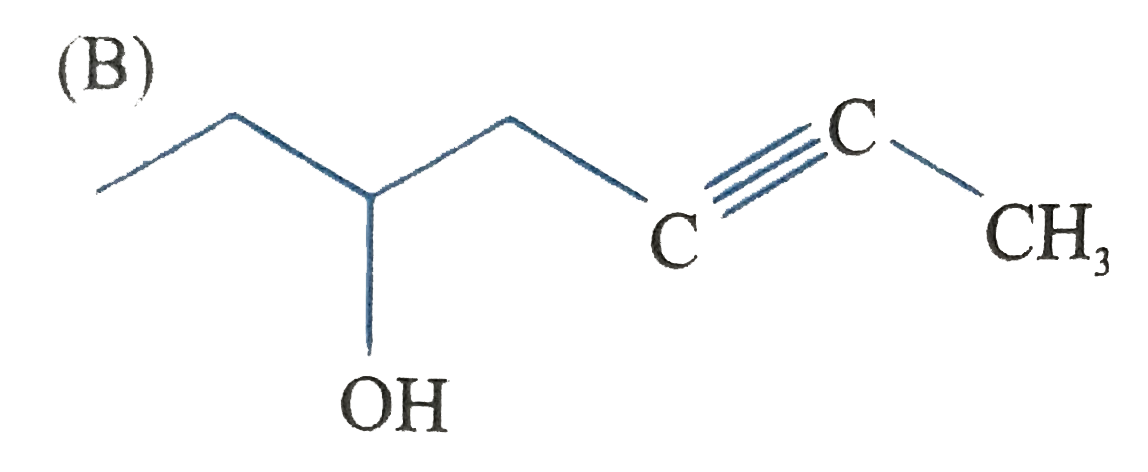Supply the reagents in the following sequence of reations :
(i) CH3CH2CH2Br(A)−−→CH3CH=CH2(B)−−→CH3CHBr−CH2Br(C)−−→CH3−C≡CH(D)−−→CH3−O∣∣C−CH3
To solve the given question, we need to identify the reagents for each step of the reaction sequence. Let's break it down step by step.
Step 1: Conversion of CH₃CH₂CH₂Br to CH₃CH=CH₂
- Reagent (A): We need to eliminate the bromine atom (Br) to form a double bond. This can be achieved through dehydrohalogenation using Alcoholic KOH (potassium hydroxide in alcohol) in the presence of heat.
Reaction:
\(
CH₃CH₂CH₂Br \xrightarrow{Alcoholic\ KOH, \Delta} CH₃CH=CH₂ + HBr
\)
Step 2: Conversion of CH₃CH=CH₂ to CH₃CHBr−CH₂Br
- Reagent (B): To add bromine across the double bond, we can use Bromine (Br₂) in a non-polar solvent like CCl₄ (carbon tetrachloride).
Reaction:
\(
CH₃CH=CH₂ \xrightarrow{Br₂/CCl₄} CH₃CHBr-CH₂Br
\)
Step 3: Conversion of CH₃CHBr−CH₂Br to CH₃−C≡CH
- Reagent (C): To convert the dibromide into an alkyne, we can use Alcoholic KOH again. This will facilitate the elimination of bromine atoms to form a triple bond.
Reaction:
\(
CH₃CHBr-CH₂Br \xrightarrow{Alcoholic\ KOH, \Delta} CH₃-C≡CH + 2HBr
\)
Step 4: Conversion of CH₃−C≡CH to CH₃−C(=O)−CH₃
- Reagent (D): To convert the alkyne to a ketone, we can use Dilute H₂SO₄ in the presence of HgSO₄ (mercuric sulfate), which facilitates oxymercuration followed by tautomerization.
Reaction:
\(
CH₃-C≡CH \xrightarrow{H₂SO₄/HgSO₄} CH₃-C(=O)-CH₃
\)
Summary of Reagents:
- (A) Alcoholic KOH (heat)
- (B) Br₂ in CCl₄
- (C) Alcoholic KOH (heat)
- (D) Dilute H₂SO₄ and HgSO₄
---
- Reagent (A): We need to eliminate the bromine atom (Br) to form a double bond. This can be achieved through dehydrohalogenation using Alcoholic KOH (potassium hydroxide in alcohol) in the presence of heat.
Reaction:
\(
CH₃CH₂CH₂Br \xrightarrow{Alcoholic\ KOH, \Delta} CH₃CH=CH₂ + HBr
\)
- Reagent (B): To add bromine across the double bond, we can use Bromine (Br₂) in a non-polar solvent like CCl₄ (carbon tetrachloride).
Reaction:
\(
CH₃CH=CH₂ \xrightarrow{Br₂/CCl₄} CH₃CHBr-CH₂Br
\)
- Reagent (C): To convert the dibromide into an alkyne, we can use Alcoholic KOH again. This will facilitate the elimination of bromine atoms to form a triple bond.
Reaction:
\(
CH₃CHBr-CH₂Br \xrightarrow{Alcoholic\ KOH, \Delta} CH₃-C≡CH + 2HBr
\)
- Reagent (D): To convert the alkyne to a ketone, we can use Dilute H₂SO₄ in the presence of HgSO₄ (mercuric sulfate), which facilitates oxymercuration followed by tautomerization.
Reaction:
\(
CH₃-C≡CH \xrightarrow{H₂SO₄/HgSO₄} CH₃-C(=O)-CH₃
\)
- (A) Alcoholic KOH (heat)
- (B) Br₂ in CCl₄
- (C) Alcoholic KOH (heat)
- (D) Dilute H₂SO₄ and HgSO₄
Similar Questions
Knowledge Check
CH3CH2CH2−O∣∣C−H+CH3−C≡CHNa,NH3(l)−−−−−−−→
A B
B C
C D
D
The reaction CH2=CH−CH3+HBr→CH3−Br∣CHCH3 is
ANucleophilic additionBElectrophilic additionCElectrophilic substitutionDFree radical additionThe IUPAC name of CH3−CH3∣CH−O∣∣C−CH2CH2OH is
A(1) 4-methyl-3-oxopentan-1-olB(2) 2-merthyl-5-hydroxypentan-3-oneC(3)1-hydroxy-4-methylpentan-3-oneD(4) hexan-1-ol-3-one
Supply the reagents in the following sequence of reations :
(iv)CH3−CH=CH2[A]−−→CH3CH2CH2Br[B]−−→C6H5CH2CH2CH3
View SolutionSupply the reagents in the following sequence of reations :
(ii)CH4[A]−−→CH3Br[B]−−→C6H5CH3[C]−−→C6H5COOH
View SolutionSupply the reagents in the following sequence of reations :
(ii)CH4[A]−−→CH3Br[B]−−→C6H5CH3[C]−−→C6H5COOH
View SolutionCH3Br−CH2−O∣∣C−CH2CH3
View SolutionWhich of the following carbocation is most stable ?
(a) (CH3)3C.+CH2 (b) (CH3)3+C (c) CH3CH2+CH2 (d) CH3+CHCH2CH3
View Solution
